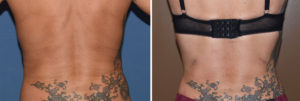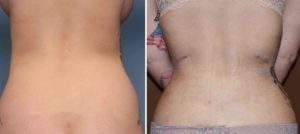Rib removal surgery removes the last anatomic barrier to maximizing horizontal waistline reduction. Removal of the free floating ribs allows the overlying soft tissue to collapse inward. When combined with flank liposuction and some muscle removal, whatever waistline reduction is possible will be achieved. Whether this meet the patient’s expectations can not be completely known until after surgery but whatever the result becomes the patient can take solace in knowing all that can be done has been done.
Posterior rib removal requires an incision on each side of the back to do so. This incision must be centered over rib #11 and its size has been reduced down to 5 cms with a lot of experience. An incision this small limits the extent of what can be done underneath it. This is why it is so critical to center it over rib #11 as rib #10 can be taken as well if so desired. Since this small incision allows one to only remove one rib above or below it, if the incision is misplaced higher or lower it will affect what ribs can be removed.

Back skin is rather thick and this always works against creating a virtually undetectable scar. But when compared to scars from traditional rib surgery for other medical purposes, this body reshaping operation results in a scar that is much shorter in length and with a far better aesthetic outcome.
Dr. Barry Eppley
Indianapolis, Indiana



